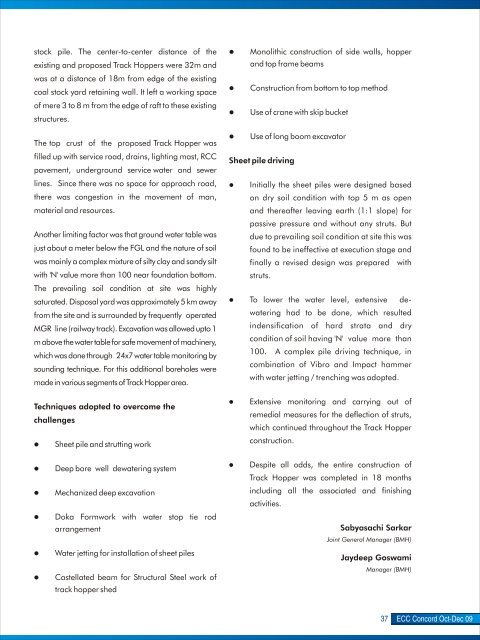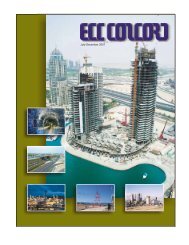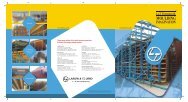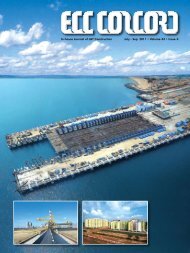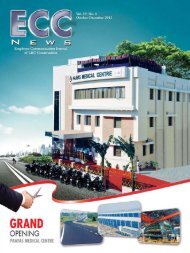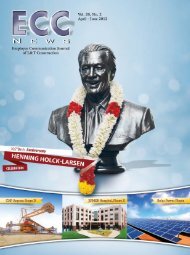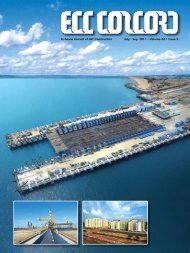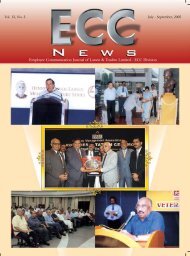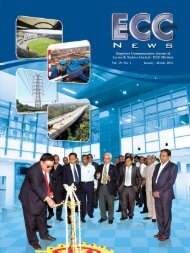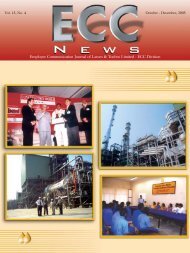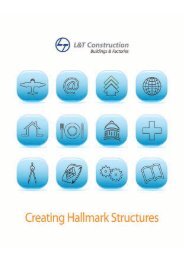Oct - Dec 2009 • Vol. No. 32 Issue No. 2 • - L&T Construction
Oct - Dec 2009 • Vol. No. 32 Issue No. 2 • - L&T Construction
Oct - Dec 2009 • Vol. No. 32 Issue No. 2 • - L&T Construction
Create successful ePaper yourself
Turn your PDF publications into a flip-book with our unique Google optimized e-Paper software.
stock pile. The center-to-center distance of the Monolithic construction of side walls, hopper<br />
existing and proposed Track Hoppers were <strong>32</strong>m and and top frame beams<br />
was at a distance of 18m from edge of the existing<br />
coal stock yard retaining wall. It left a working space<br />
<strong>Construction</strong> from bottom to top method<br />
of mere 3 to 8 m from the edge of raft to these existing Use of crane with skip bucket<br />
structures.<br />
The top crust of the proposed Track Hopper was<br />
filled up with service road, drains, lighting mast, RCC<br />
pavement, underground service water and sewer<br />
Use of long boom excavator<br />
Sheet pile driving<br />
lines. Since there was no space for approach road, Initially the sheet piles were designed based<br />
there was congestion in the movement of man, on dry soil condition with top 5 m as open<br />
material and resources. and thereafter leaving earth (1:1 slope) for<br />
passive pressure and without any struts. But<br />
Another limiting factor was that ground water table was due to prevailing soil condition at site this was<br />
just about a meter below the FGL and the nature of soil found to be ineffective at execution stage and<br />
was mainly a complex mixture of silty clay and sandy silt finally a revised design was prepared with<br />
with 'N' value more than 100 near foundation bottom. struts.<br />
The prevailing soil condition at site was highly<br />
saturated. Disposal yard was approximately 5 km away<br />
from the site and is surrounded by frequently operated<br />
MGR line (railway track). Excavation was allowed upto 1<br />
m above the water table for safe movement of machinery,<br />
which was done through 24x7 water table monitoring by<br />
sounding technique. For this additional boreholes were<br />
made in various segments of Track Hopper area.<br />
Techniques adopted to overcome the<br />
challenges<br />
Sheet pile and strutting work<br />
Deep bore well dewatering system<br />
Mechanized deep excavation<br />
Doka Formwork with water stop tie rod<br />
arrangement<br />
Water jetting for installation of sheet piles<br />
Castellated beam for Structural Steel work of<br />
track hopper shed<br />
To lower the water level, extensive de-<br />
watering had to be done, which resulted<br />
indensification of hard strata and dry<br />
condition of soil having 'N' value more than<br />
100. A complex pile driving technique, in<br />
combination of Vibro and Impact hammer<br />
with water jetting / trenching was adopted.<br />
Extensive monitoring and carrying out of<br />
remedial measures for the deflection of struts,<br />
which continued throughout the Track Hopper<br />
construction.<br />
Despite all odds, the entire construction of<br />
Track Hopper was completed in 18 months<br />
including all the associated and finishing<br />
activities.<br />
Sabyasachi Sarkar<br />
Joint General Manager (BMH)<br />
Jaydeep Goswami<br />
Manager (BMH)<br />
37<br />
ECC Concord <strong>Oct</strong>-<strong>Dec</strong> 09


